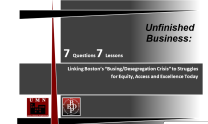A couple of weeks ago, members of BBDP held a workshop for MIRA, the Massachusetts Immigration and Refugee Advocacy Coalition. The topic of the workshop was systemic racism, immigration, and migration. Over the course of two days, we discussed the development of white supremacist systems, how they effect our work, and what we can do to combat racism in our respective organizations. As part of our presentation, LaDawn Strickland, one of the designers of the workshop and a longtime BBDP contributor, had developed a historical timeline that was posted on the wall on the second day of the event.
The points on the timeline marked the arrival of different immigrant groups to the North American continent before and after the establishment of the United States. These included the first large-scale arrivals of English colonists, captive Africans, and Irish, German, Chinese, and Mexican immigrants, among others. The timeline included points, too, marking the history of migrations within the country, noting especially the way indigenous groups were forced from their land through violence and legislation (enforced with violence), first westward, then, upon the “closing of the frontier,” onto reservations. Participants were asked to make the timeline their own by adding their personal and family history to the points marking the passages of laws, the movements of groups, and the changing definitions of who gets to be a citizen and who gets to be “white”.
In all the feedback we got from people at the end of our time with MIRA, the thing we heard the most was an appreciation for the history and the desire to learn more. Our audience, which was international and cross-generational, really wanted to go deeper on not only their own personal ethnic and racial histories, but also how they developed in this country, how whiteness was constructed over time, and what forces have shaped the movements of populations. As the workshop designers, I think we were surprised a little bit at this. Being involved with BBDP for so long, perhaps we took the history for granted, as that is our focus much of the time. But what we heard back is that there is a hunger not being satisfied. People want to know the history, not just to be able to spout trivial names and dates, but to learn how we got to this moment, today– geographically, economically, racially, and politically.
Over the course of our project, we’ve seen the power that is tapped into when we change our conception of history from a static, finished process that takes place in books to a dynamic, unfinishable one that we live every day. We empower ourselves to investigate our individual and collective pasts so that we may understand more fully our present and impact our future. What we learned with MIRA is that this need for historical knowledge is an urgent one still today, and brought to mind a line from Michael Beckwith that comes up often in our discussions: “Choice is a function of expanded awareness.” The more we know of our past and present, the broader our options become for the future. As Boston’s skyline gets ever more crowded with cranes and luxury condos, as wealth inequality widens daily, it is crucial that our learning and understanding of history inform and expand the choices we can make.



[…] History and Learning With MIRA […]